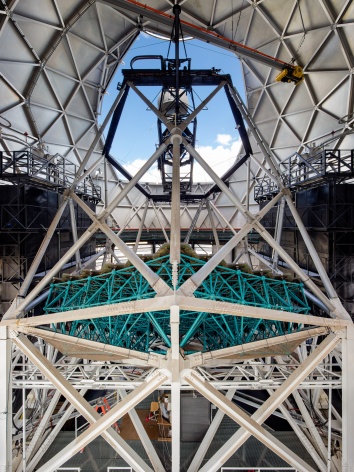.
Upgraded Hobby-Eberly Telescope dedicated April 9; Dark energy survey, other cutting-edge science on the way
9 April 2017
FORT DAVIS, Texas — The world’s third-largest telescope, the 10-meter Hobby-Eberly Telescope (HET) located at McDonald Observatory in West Texas, has completed a multiyear $40 Million upgrade to enable it to take on the biggest challenges in astronomy today: unraveling the mystery of dark energy, probing distant galaxies and black holes, discovering and characterizing planets around other stars and much more. The HET Board is celebrating with a dedication ceremony today.
“The entire Board, as well as the HET astronomy community, are excited about the telescope upgrade and the new science it will enable,” said Dr. Larry Ramsey, chair of the HET Board and professor of astronomy at Penn State. “The upgraded HET will conduct the first major study of how dark energy changes over time and we all look forward to new and exciting results in this area and others.”
HET’s upgrade included a variety of aspects. The telescope’s field of view has been expanded to 70 percent of the diameter of the full Moon and now views an area of sky 120 times larger than before. And HET now sports an innovative new set of optics. “The Harold C. Simmons Dark Energy Optical System is one of the most complex optical systems ever deployed in astronomy,” said McDonald Observatory Director Dr. Taft Armandroff of The University of Texas at Austin. The Simmons System rides on the telescope’s new tracker, or “top end,” which enables tracking and guiding on cosmic targets.
A practically new telescope deserves a new set of instruments to make the most of its capabilities. Astronomers and engineers have built a suite of four instruments, each optimized for a different kind of research, for the new HET. (See appendix for details.)
The upgrade is an integral part of the upcoming Hobby-Eberly Telescope Dark Energy Experiment (HETDEX), a four-year project starting later this year that will study dark energy, the mysterious force causing the universe’s rate of expansion to speed up. This survey will look back 11 billion years and determine if dark energy has changed over time.
The HET was originally dedicated in 1997. It is a partnership between The University of Texas at Austin, Penn State, and two German institutions, Georg-August-Universität Göttingen and Ludwig-Maximilians-Universität München.
Today's event will welcome Texas elected officials, philanthropic donors, leadership from The University of Texas at Austin and Penn state, officials from the National Science Foundation and scientists. The telescope upgrade was funded by a combination of federal, state and private sources
Appendix: HET’s New Instruments
The Low Resolution Spectrograph 2 (LRS2) became fully operational last July. It enables highly sensitive studies of faint, distant galaxies; supermassive black holes and more. A spectrograph enables the study of cosmic objects' chemical composition, temperature and motion. LRS2 does this for the faintest objects and utilizes an innovative input that divides up an area of sky and efficiently reformats it to feed into the spectrograph. LRS2 was developed by The University of Texas at Austin.
The Visible Integral-field Replicable Unit Spectrograph (VIRUS) will enable a major study of dark energy, the mysterious force that’s causing the expansion of the universe to speed up over time. It consists of 156 spectrographs that analyze light captured by HET and fed through 35,000 optical fibers to be captured by cameras with a total of 633 megapixels. The combination of the upgraded HET and VIRUS creates the world’s most powerful spectroscopic capability for surveying large areas of sky. VIRUS is led by The University of Texas at Austin with contributions from the Leibniz Institute for Astrophysics Potsdam, Texas A&M University and The University of Oxford with support from a National Science Foundation (NSF) grant.
The Habitable Zone Planet Finder (HPF) is an ultra-stable, optical-fiber-fed, high resolution infrared spectrograph system designed for high precision velocity measurements of nearby small, cool stars. HPF will search for and detect the small Doppler wobble caused by planets orbiting in their “habitable zones,” where liquid water can exist. Planets in this zone could potentially foster life. The red dwarf stars HPF will study are the most common stars in the Milky Way galaxy. The construction of HPF is funded by NSF Major Research Instrumentation and Advanced Technology and Instrumentation grants to Penn State. Delivery of the instrument to HET is expected before the end of this year.
The High Resolution Spectrograph (HRS) is one of HET’s original instruments that has been upgraded substantially in support of various missions. HRS is used to study how stars synthesize the elements and how the chemistry of our Milky Way galaxy changes with time. HRS also searches for planets around other stars and observes exoplanets discovered by the NASA spacecraft Keplerand the future TESS mission. The combination of HRS and spacecraft data allows detailed characterization of the exoplanets that neither can provide alone. HRS was developed by The University of Texas at Austin.
-


